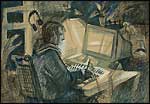
Flemish mathematician and engineer Simon Stevin (1548-1620) studied the principles of mechanisms and machines. He had seen many perpetual machine proposals. One particularly interested him: a chain looped over a pair of asymmetric ramps. Some made the claim that it should move of its own accord because there were more balls, and therefore a greater weight on one side of the apparatus. They were sure it would move if only you could get rid of that pesky friction.
Stevin analyzed this and showed that the chain would not move, for in fact the system is in static equilibrium. In doing this he invented an important principle for the analysis of machines: the Principle of Virtual Work that may be found in engineering mechanics books even today. So important was this principle, that this picture of the ball-chain appears on the title page of Stevin's book on mechanics, and on his gravestone.
Stevin's achievement was an early example of how one can carefully analyze a mechanical system to determine whether (and how) it works. Stevin accomplished this long before the force analysis was understood, and before formulation of the laws of thermodynamics. Stevin also adopted the useful tactic of analyzing mechanisms in the "ideal" case where friction is assumed absent.
The Museum of Unworkable Devices

Saturday, February 17, 2007
Simon Stevin's Problem
Posted by
Valery
at
7:12 PM
![]()
Subscribe to:
Post Comments (Atom)



No comments:
Post a Comment